Approaches to Disposal of Nuclear Waste
Abstract
1. Introduction
1.1. Nuclear (Radioactive) Waste
1.2. Consensus on Disposal
1.3. Aims of Disposal
- (a)
- Site (such as using an arid region or unsaturated, mountainous site, etc.);
- (b)
- Emplacement depth (near-surface, above/below grade, intermediate depth, deep geological);
- (c)
- Use of water-resistant caps (runoff drainage layer, clay barrier);
- (d)
- Long-lived containment (borehole disposal), etc.
- Nuclear wastes are disposed of using the simplest disposal concept available, which is consistent with the hazards of waste and for which safety and environmental protection can be demonstrated.
- The most hazardous wastes are disposed using greater levels of engineering to provide for increased containment and/or are disposed of at greater possible depth to increase isolation from the surface environment.
- Where existing disposal facilities are available, consideration is given to first using them before developing new disposal facilities.
1.4. Disposal as End Point of Management
2. Nuclear Waste Classification for Disposal
2.1. IAEA Classification
- VSLW is radioactive waste that can be stored for decay over a limited period of no longer than a few years, with subsequent clearance from regulatory control, and typically includes radioactive wastes generated by uses of nuclear energy in research and medicine;
- VLLW is radioactive waste that does not need a high level of containment and isolation and because of that is suitable for disposal in near-surface landfill type facilities with limited regulatory control. Typical VLLW includes soil and rubble with low levels of activity concentration, which does not usually exceed one hundred times clearance levels for each of the radionuclides present. In some countries, VLLW is disposed of in purpose-built disposal facilities, e.g., these can be in the form of earthen trenches with engineered covers, although it can be disposed of with LLW;
- LLW has limited amounts of long-lived radionuclides in it and because of that requires robust isolation and containment for periods of up to a few hundred years. LLW is suitable for disposal in engineered near-surface disposal facilities (NSDF). LLW covers a very broad range of waste with long-lived radionuclides only at relatively low levels of activity concentration. LLW is generated in most facilities involved in nuclear power production, nuclear research, and nuclear medicine. It is common practice to dispose of LLW in NSDFs, although options for the disposal of LLW include simplified facilities such as engineered trenches or concrete vaults in which waste containers are placed. An engineered or earthen cap is then placed over the waste containers to minimise water infiltration. The NSDFs are subject to surveillance until the hazard associated with the nuclear waste has declined to acceptable (e.g., clearance) levels. Some countries prefer disposing of LLW in sub-surface facilities or co-locating LLW with ILW or spent nuclear fuel (SNF) in deeper facilities;
- ILW is radioactive waste that requires a greater degree of containment and isolation than that provided by NSDFs although it needs no provision for radiogenic heat dissipation. The ILW requires disposal at greater depths, of the order of from tens of metres to at one or even a few hundred metres. Moreover, disposal at depths of greater than several tens of metres is generally considered to be the most appropriate option for ILW. Co-disposal of ILW with SNF and HLW is an effective option considered in many countries. A precise boundary between LLW and ILW does not exists although a limit content of 400 Bq/g on average and up to 4000 Bq/g for individual packages for long-lived alpha emitting radionuclides has been adopted in many countries following the recommendation of IAEA [16]. The actual boundary-limiting levels result in each specific case from the performance and safety analysis reports and cannot be generic to all facilities. For long-lived beta- and/or gamma-emitting radionuclides, e.g., 14C, 36Cl, 63Ni, 93Zr, 94Nb, 99Tc, and 129I, the allowable average activity concentrations may be considerably higher (up to tens of kBq/g) although they are always specific to the site and disposal facility [16];
- HLW is radioactive waste with levels of activity concentration high enough to require shielding in handling operations and that generates significant quantities of radiogenic heat due to the decay of nuclear waste radionuclides. Depending on the volume of waste, the heat generation levels of HLW are typically above a few W/m3 for typical volumes of about one cubic metre. HLW can also be nuclear waste with large amounts of long-lived radionuclides that need to be considered in the design of disposal facilities. Disposal in deep geological disposal facilities (GDF) located in stable geological formations, usually several hundred metres or more below the surface, is the generally recognised HLW disposal option. While most countries with spent fuel and HLW are working towards national solutions, others, for mainly economic reasons, have indicated an interest in developing multinational disposal facilities [13].
2.2. IAEA Selection Tool
2.3. National Classifications
- Negligible-heat-generating radioactive waste is radioactive waste with negligible heat generation, i.e., average heat output of less than about 200 W/m3 of waste (corresponding to a 3-degree K increase in temperature at the wall of the disposal chamber caused by the decay heat from the radionuclides contained in the waste packages);
- Heat-generating radioactive waste is characterised by high activity concentrations and, therefore, by high decay heat output. This category includes reprocessing residues and spent nuclear fuel.
3. Radiotoxicity and Retention Times of Disposal
3.1. Radiotoxicity
3.2. Retention Times of Disposal
4. Multibarrier Approach
4.1. Multi-Barrier Defence System
4.2. Engineered Barrier System (EBS)
4.3. Delay of Radionuclide Release
4.4. Natural Barrier System (NBS)
- Isolation of waste from near-surface processes and human activities.
- Protection of the biosphere.
- Limitation of any release from the progressively degrading EBS.
- Dispersion and diluting the flux of long-lived radionuclides potentially released from the wasteform.
- Stability: the site is expected to possess a stable geology with overall predictability of site evolution.
- Acceptable hydrogeology: limited contact between waste and groundwater is preferred to minimise the mobilisation and transport of radionuclides.
- Suitable geochemistry: characteristics minimising the potential for radionuclide migration, for example, reducing conditions, are preferred.
- Low seismicity: the potential of earthquakes to affect the site must be considered.
5. Nuclear Waste Disposal Options
5.1. Graded Approach
- Near surface (shallow);
- Intermediate;
- Deep (geological).
5.2. Disposal Options
6. Disposal Practices
6.1. Disposal Examples
6.2. Borehole Disposal Facilities (BDFs)
7. Safety of Nuclear Waste Disposal
- Limited doses or risks (relative).
- Levels of radiological protection to future generations provided at the same level as at present.
- Ensuring that the additive impact of the disposal is limited.
8. Conclusions
Author Contributions
Funding
Data Availability Statement
Acknowledgments
Conflicts of Interest
References
- IAEA. Radiation Protection and Safety of Radiation Sources: International Basic Safety Standards; IAEA Safety Standards Series GSR Part 3; IAEA: Vienna, Austria, 2014. [Google Scholar]
- IAEA. Scientific and Technical Basis for Near-surface Disposal of Low and Intermediate Level Waste; TRS-412; IAEA: Vienna, Austria, 2003. [Google Scholar]
- IAEA. Scientific and Technical Basis for Geological Disposal of Radioactive Wastes; TRS-413; IAEA: Vienna, Austria, 2003. [Google Scholar]
- Crossland, I. Disposal of radioactive waste. In Nuclear Fuel Cycle Science and Engineering; Woodhead Publishing Series in Energy; Woodhead Publishing: Sawston, UK, 2012; Chapter 18; pp. 531–557. [Google Scholar] [CrossRef]
- Ahn, J.; Apted, M.J. Geological Repository Systems for Safe Disposal of Spent Nuclear Fuels and Radioactive Waste, 2nd ed.; Elsevier: Woodhead/Cambridge, UK, 2017; 778p. [Google Scholar]
- IAEA. IAEA Nuclear Safety and Security Glossary; IAEA: Vienna, Austria, 2022. [Google Scholar]
- Rohlig, K.-J. Disposal and other conceivable strategy ‘endpoints’ for different types of waste. In Nuclear Waste: Management, Disposal and Governance; Rohlig, K.-J., Ed.; IOP Publishing Ltd: Bristol, UK, 2022; Chapter 7; pp. 7.1–7.19. [Google Scholar] [CrossRef]
- Rohlig, K.-J. Geologic (‘deep’) disposal of high-level and other long-lived waste: Host rocks, concepts, current international status. In Nuclear Waste: Management, Disposal and Governance; IOP Publishing Ltd: Bristol, UK, 2022; Chapter 8; pp. 8.1–8.25. [Google Scholar] [CrossRef]
- IAEA. Disposal of Radioactive Waste Specific Safety Requirements; IAEA Safety Standards Series No. SSR-5; IAEA: Vienna, Austria, 2011; Available online: https://www-pub.iaea.org/MTCD/Publications/PDF/Pub1449_web.pdf (accessed on 19 September 2022).
- IAEA. Selection of Technical Solutions for the Management of Radioactive Waste; TECDOC-1817; IAEA: Vienna, Austria, 2017. [Google Scholar]
- IAEA. Design Principles and Approaches for Radioactive Waste Repositories; NW-T-1.27; IAEA: Vienna, Austria, 2020. [Google Scholar]
- ICRP. Protection of the Public in Situations of Prolonged Radiation Exposure; Publication 82; Annals of the ICRP Vol. 29, Nos 1-2; Pergamon Press: Oxford, UK; New York, NY, USA, 1999. [Google Scholar]
- IAEA. Policies and Strategies for Radioactive Waste Management; IAEA Nuclear Energy Series, NW-G-1.1; IAEA: Vienna, Austria, 2009; 68p, Available online: http://www.pub.iaea.org/MTCD/publications/PDF/Pub1396_web.pdf (accessed on 19 September 2022).
- IAEA. Fundamental Safety Principles; IAEA Safety Standards Series No. SF-1; IAEA: Vienna, Austria, 2006. [Google Scholar]
- Metcalf, P.; Batandjieva, B. International safety standards for radioactive waste (RAW) management and remediation of contaminated sites. In Radioactive Waste Management and Contaminated Site Clean-up: Processes, Technologies and International Experience; Lee, W.E., Ojovan, M.I., Jantzen, C.M., Eds.; Woodhead Publishing Series in Energy No. 48; Woodhead Publishing: Cambridge, UK, 2013; Chapter 3; pp. 73–114. ISBN 0 85709 435 1. [Google Scholar]
- IAEA. Classification of Radioactive Waste; General Safety Guide GSG-1; IAEA: Vienna, Austria, 2009. [Google Scholar]
- IAEA. Joint Convention on the Safety of Spent Fuel Management and on the Safety of Radioactive Waste Management; IAEA: Vienna, Austria, 2006; Available online: http://www-ns.iaea.org/conventions/waste-jointconvention.asp (accessed on 18 August 2022).
- DEFRA. Policy for the Long Term Management of Solid Low Level Radioactive Waste in the United Kingdom; Department for Environment, Food and Rural Affairs: London, UK, 2007. [Google Scholar]
- Germany. Joint Convention on the Safety of Spent Fuel Management and on the Safety of Radioactive Waste Management Report of the Federal Republic of Germany for the Fourth Review Meeting. Report prepared by Federal Ministry for the Environment, Nature Conservation and Nuclear Safety (BMU), August 2011. Available online: http://www.bmu.de/files/english/pdf/application/pdf/jc_4_bericht_deutschland_en.pdf (accessed on 18 August 2022).
- Cohen, B.L. High-level radioactive waste from light-water reactors. Rev. Mod. Phys. 1977, 49, 1–20. [Google Scholar] [CrossRef]
- Koplik, C.M.; Kaplan, M.F.; Ross, B. The safety of repositories for radioactive wastes. Rev. Mod. Phys. 1982, 54, 269–312. [Google Scholar] [CrossRef]
- Chapman, N.; Hooper, A. The disposal of radioactive wastes underground. Proc. Geol. Assoc. 2012, 123, 46–63. [Google Scholar] [CrossRef]
- Ojovan, M.I.; Lee, W.E.; Kalmykov, S.N. An Introduction to Nuclear Waste Immobilisation, 3rd ed.; Elsevier: Amsterdam, The Netherlands, 2019; 497p. [Google Scholar]
- IAEA. Implications of Partitioning and Transmutation in Radioactive Waste Management; IAEA: Vienna, Austria, 2004; p. 127. [Google Scholar]
- Westlen, D. Reducing radiotoxiciti in the long run. Progr. Nucl. Energy 2007, 49, 597–605. [Google Scholar] [CrossRef]
- NEA. Potential Benefits and Impacts of Advanced Nuclear Fuel Cycles with Actinide Partitioning and Transmutation; Rep. 6894; NEA OECD: Paris, France, 2011; 73p. [Google Scholar]
- Ojovan, M.I.; Lee, W.E.; Barinov, A.S.; Startceva, I.V.; Bacon, D.H.; McGrail, B.P.; Vienna, J.D. Corrosion of low level vitrified radioactive waste in a loamy soil. Glass Technol. Eur. J. Glass Sci. Technol. A 2006, 47, 48–55. [Google Scholar] [CrossRef]
- Kashcheev, V.A.; Logunov, M.V.; Shadrin, A.Y.; Rykunova, A.A.; Schmidt, O.V. Strategy for the fractionation of HLW from SNF reprocessing. Radioact. Waste 2022, 2, 6–16. [Google Scholar] [CrossRef]
- OECD. Features, Events and Processes (FEPs) for Geologic Disposal of Radioactive Waste; An International Database; OECD: Paris, France, 2000. [Google Scholar]
- Hyatt, N.C.; Ojovan, M.I. Special Issue: Materials for Nuclear Waste Immobilization. Materials 2019, 12, 3611. [Google Scholar] [CrossRef]
- National Research Council. Waste Forms Technology and Performance: Final Report; National Academies Press: Washington, DC, USA, 2011; p. 308. [Google Scholar]
- OECD. Engineered Barrier Systems and the Safety of Deep Geological Repositories; Report EUR 19964 EN.; OECD: Issy-Ies-Moulineaux, France, 2003. [Google Scholar]
- Frankel, G.S.; Vienna, J.D.; Lian, J.; Scully, J.R.; Gin, S.; Ryan, J.V.; Wang, J.; Kim, S.H.; Windl, W.; Du, J. A comparative review of the aqueous corrosion of glasses, crystalline ceramics, and metals. NPJ Mater. Degrad. 2018, 2, 15. [Google Scholar] [CrossRef]
- Barinov, A.S.; Ojovan, M.I.; Ojovan, N.V. Corrosion of carbon steel containers during open site tests of vitrified radioactive waste. Mat. Res. Soc. Symp. Proc. 1998, 506, 971–972. [Google Scholar] [CrossRef]
- Ojovan, M.I.; Hand, R.J.; Ojovan, N.V.; Lee, W.E. Corrosion of alkali-borosilicate waste glass K-26 in non-saturated conditions. J. Nucl. Mat. 2004, 340, 12–24. [Google Scholar] [CrossRef]
- Kochkin, B.; Malkovsky, V.; Yudintsev, S.; Petrov, V.; Ojovan, M. Problems and perspectives of borehole disposal of radioactive waste. Prog. Nucl. Energy 2021, 139, 103867. [Google Scholar] [CrossRef]
- Chapman, N.A. Who Might Be Interested in a Deep Borehole Disposal Facility for Their Radioactive Waste? Energies 2019, 12, 1542. [Google Scholar] [CrossRef]
- Freeze, G.A.; Stein, E.; Brady, P.V.; Lopez, C.; Sassani, D.; Travis, K.; Gibb, F.; Beswick, J. Deep borehole safety case. Energies 2019, 12, 2141. [Google Scholar] [CrossRef]
- IAEA. Management of Disused Sealed Radioactive Sources; IAEA Nuclear Energy Series No. NW-T-1.3; IAEA: Vienna, Austria, 2014. [Google Scholar]
- Deep Isolation. Preliminary Assessment of a Deep Isolation Borehole Repository as a Disposal Option for Nuclear Waste in the ERDO Countries; Deep Isolation: Berkeley, CA, USA, 2021; 36p, Available online: https://www.norskdekommisjonering.no/wp-content/uploads/2021/12/Preliminary-assessment_Deep-Isolation-borehole-repository-as-a-disposal-option-for-nuclear-waste-in-the-ERDO-countries.pdf (accessed on 18 August 2022).
- Bracke, G.; Kudla, W.; Rosenzweig, T. Status of Deep Borehole Disposal of High-Level Radioactive Waste in Germany. Energies 2019, 12, 2580. [Google Scholar] [CrossRef]
- Freeze, G.; Sassani, D.; David, O.K.-B.; Calvo, R.; Peer, G. Borehole Disposal of Radioactive Waste in Israel–20388. In Proceedings of the WM2020 Conference, Phoenix, AZ, USA, 8–12 March 2020. [Google Scholar]
- Mallants, D.; Sander, R.; Avijegon, A.; Engelhardt, H.-J. Cost Analysis of Deep Large-diameter Drill Holes–21048. In Proceedings of the WM2021 Conference, Phoenix, AZ, USA, 8–12 March 2020. [Google Scholar]
- Muller, R.A.; Finsterle, S.; Grimsich, J.; Baltzer, R.; Muller, E.A.; Rector, J.W.; Payer, J.; Apps, J. Disposal of High-Level Nuclear Waste in Deep Horizontal Drillholes. Energies 2019, 12, 2052. [Google Scholar] [CrossRef]
- Ojovan, M.I.; Guskov, A.V.; Prozorov, L.B.; Arustamov, A.E.; Poluektov, P.P.; Serebriakov, B.E. Safety assessment of bore-hole repositories for sealed radiation sources disposal. MRS Online Proc. Libr. 1999, 608, 141–146. [Google Scholar] [CrossRef]
- Chapman, N.; Dansie, A.; McCombie, C. Artifact to analogue: Archeology of arid environments points to management options for Yucca Mountain. Radwaste Solut. 2007, 14, 22–31. [Google Scholar]
- Ojovan, M.I. Challenges in the Long-Term Behaviour of Highly Radioactive Materials. Sustainability 2022, 14, 2445. [Google Scholar] [CrossRef]
- Pershukov, V.; Artisyuk, V.; Kashirsky, A. Paving the Way to Green Status for Nuclear Power. Sustainability 2022, 14, 9339. [Google Scholar] [CrossRef]
- Chersola, D.; Lomonaco, G.; Marotta, R. The VHTR and GFR and their use in innovative symbiotic fuel cycles. Prog. Nucl. Energy 2015, 83, 443–459. [Google Scholar] [CrossRef]
- Harvego, E.A.; Schultz, R.R. Generation IV Technologies. In Nuclear Engineering Handbook; Kok, K.D., Ed.; CRC Press, Taylor & Francis Group: Boca Raton, FL, USA, 2009; pp. 227–242. [Google Scholar]
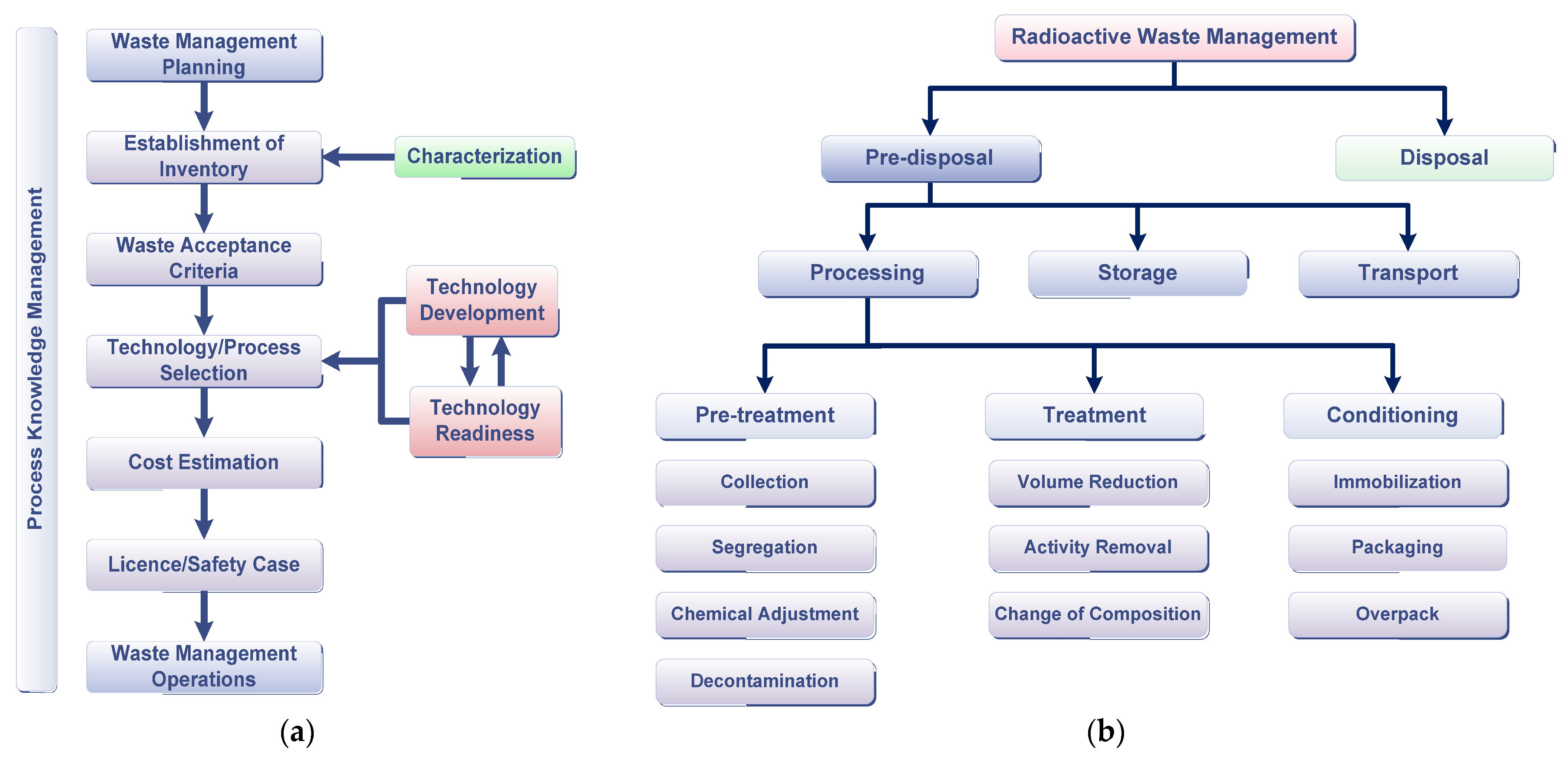
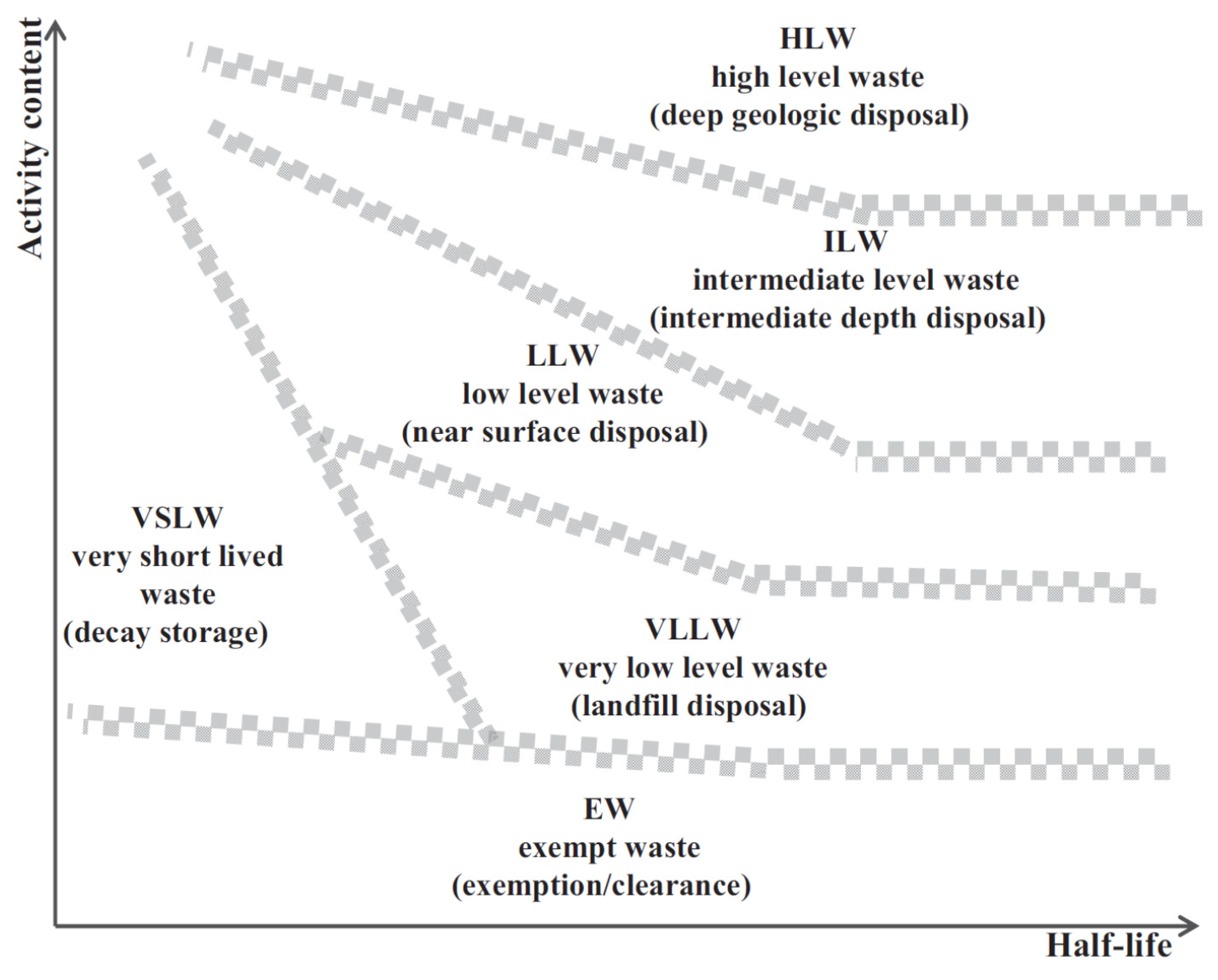
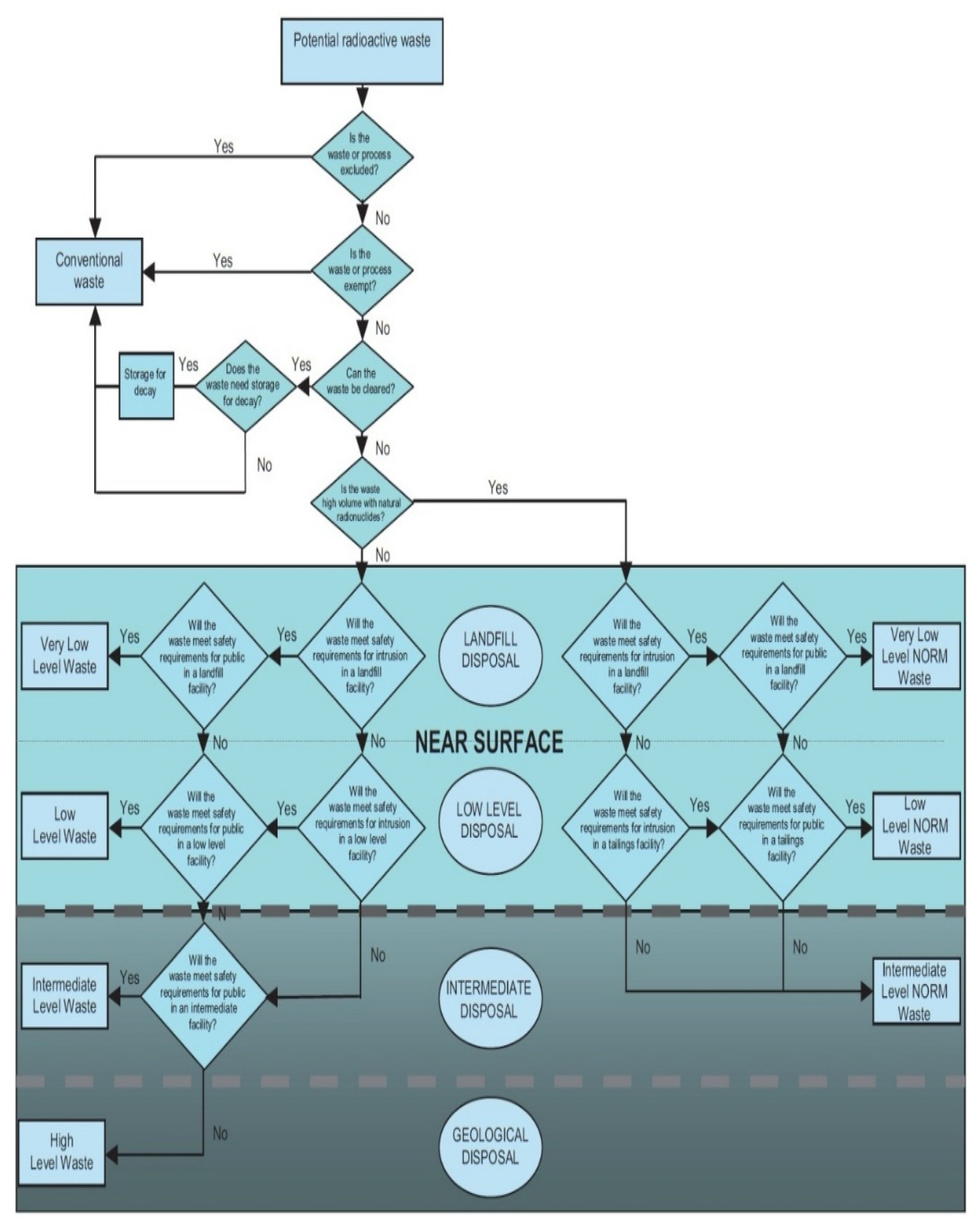
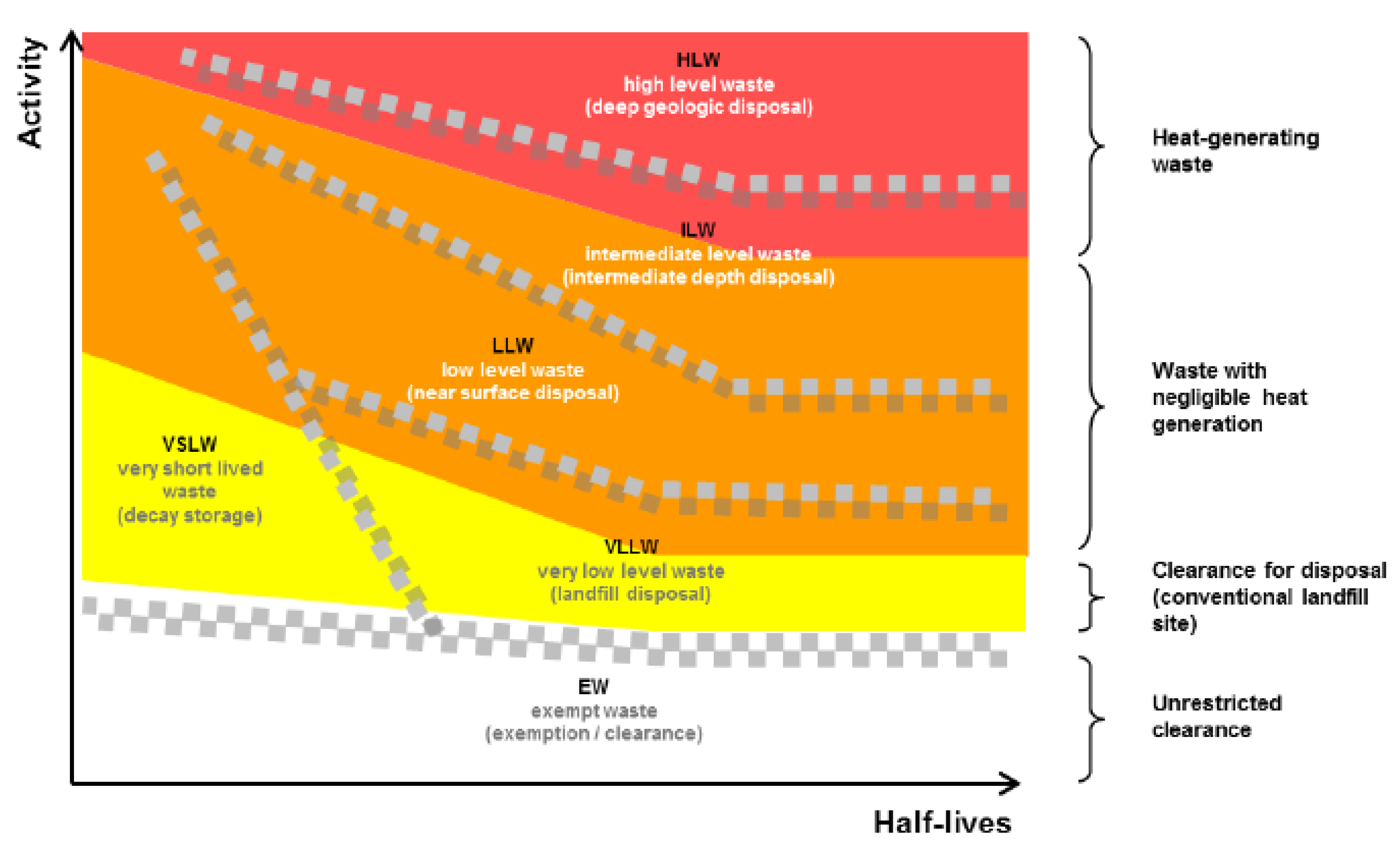
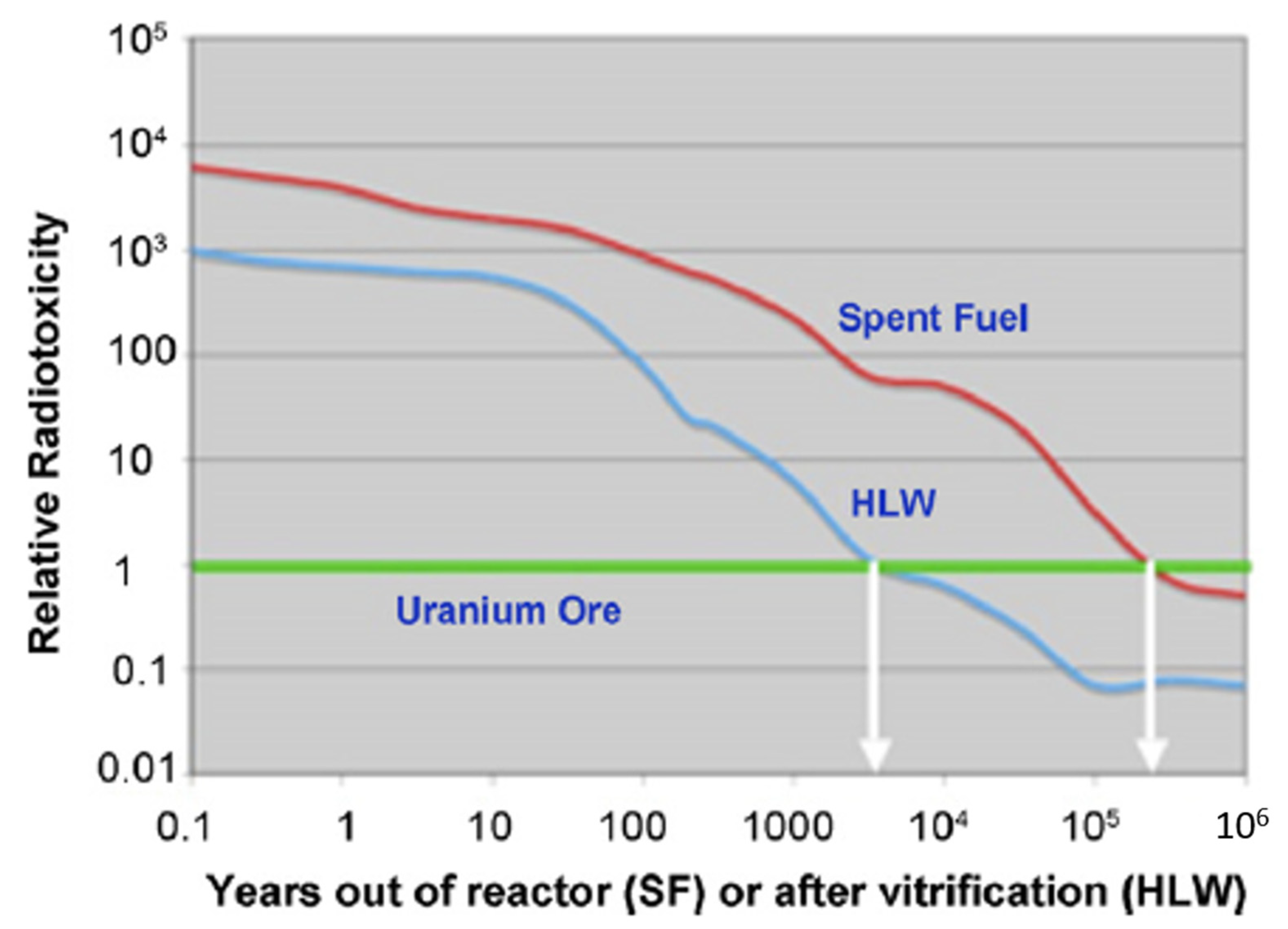

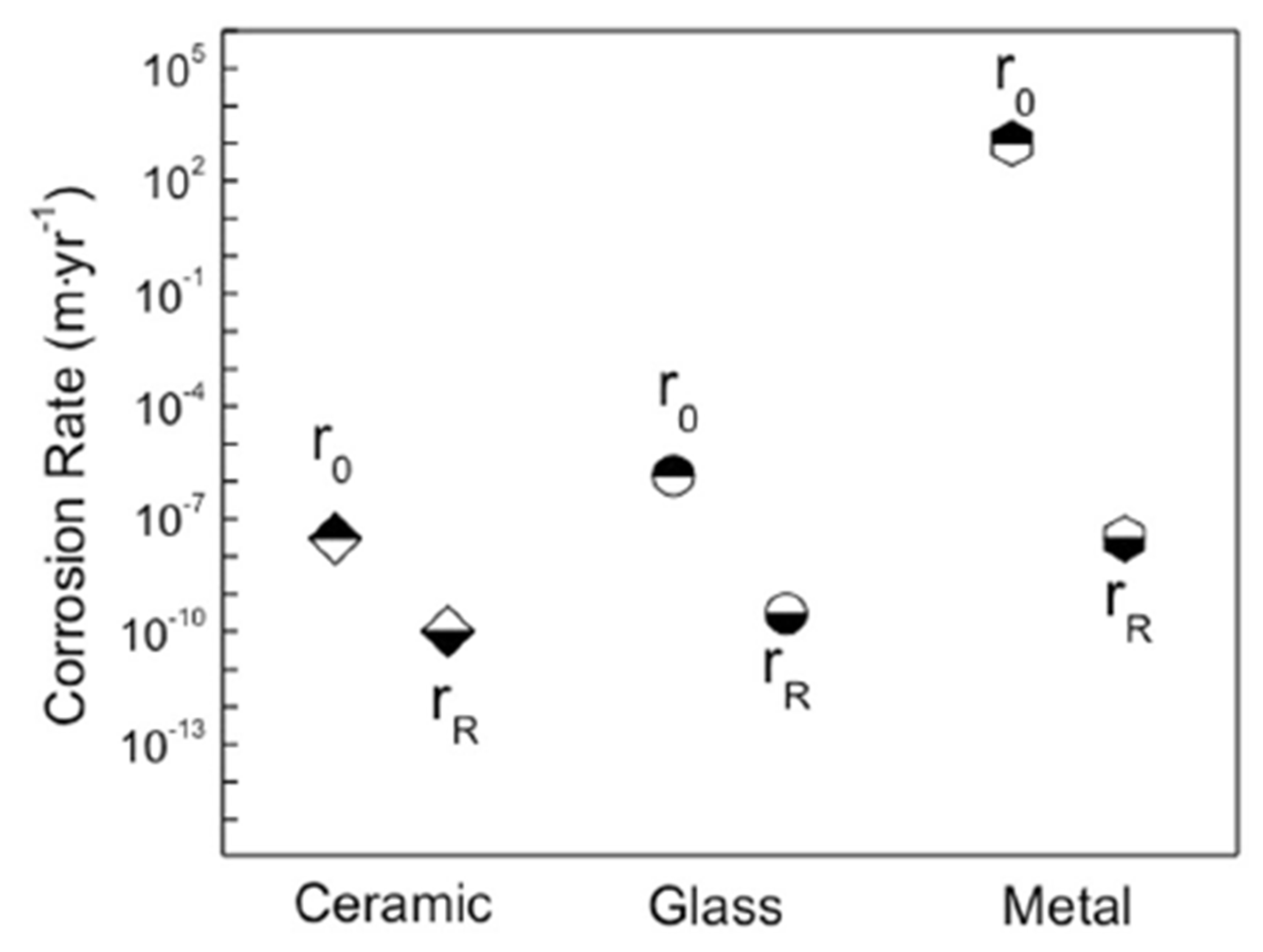
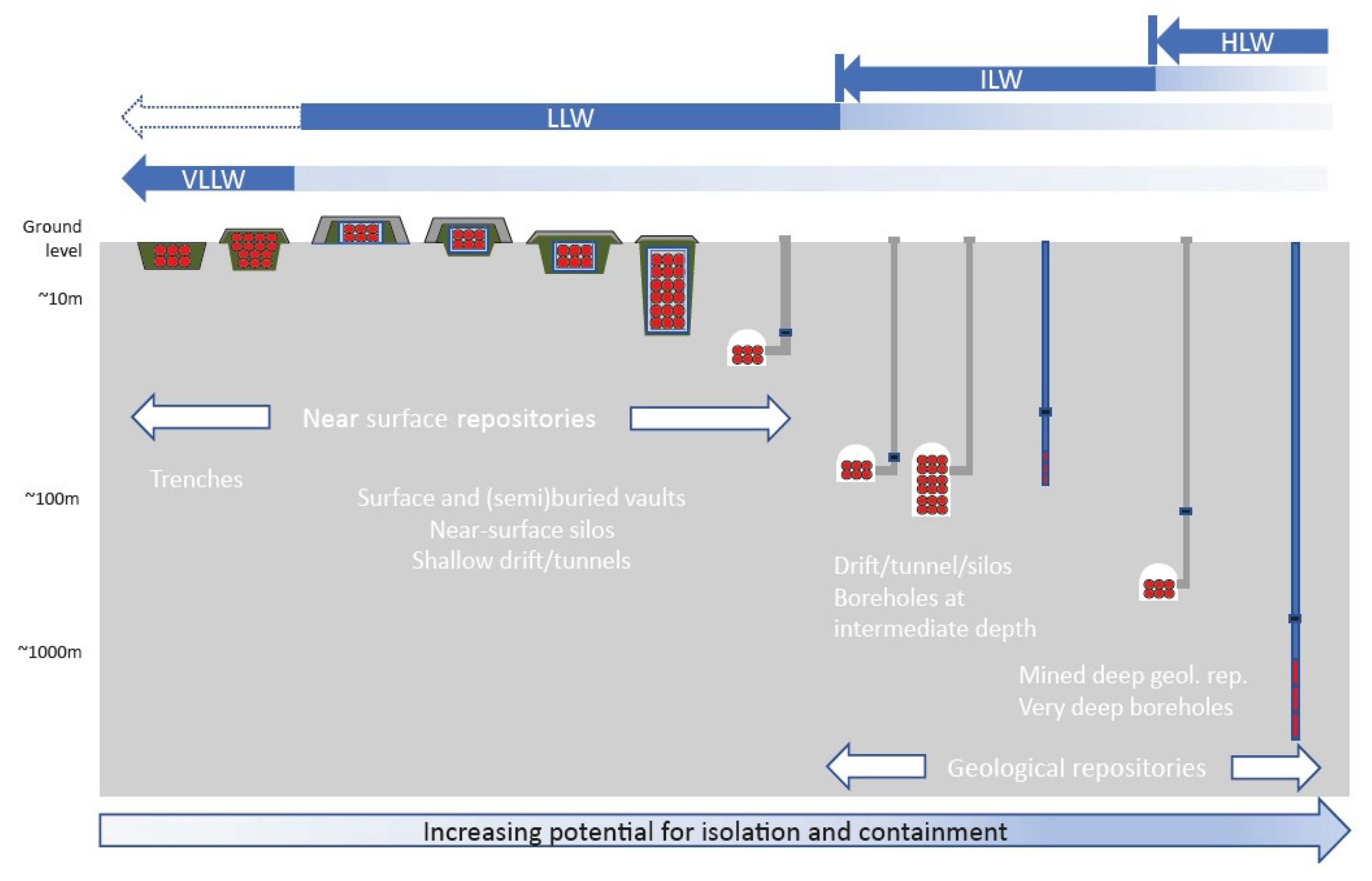
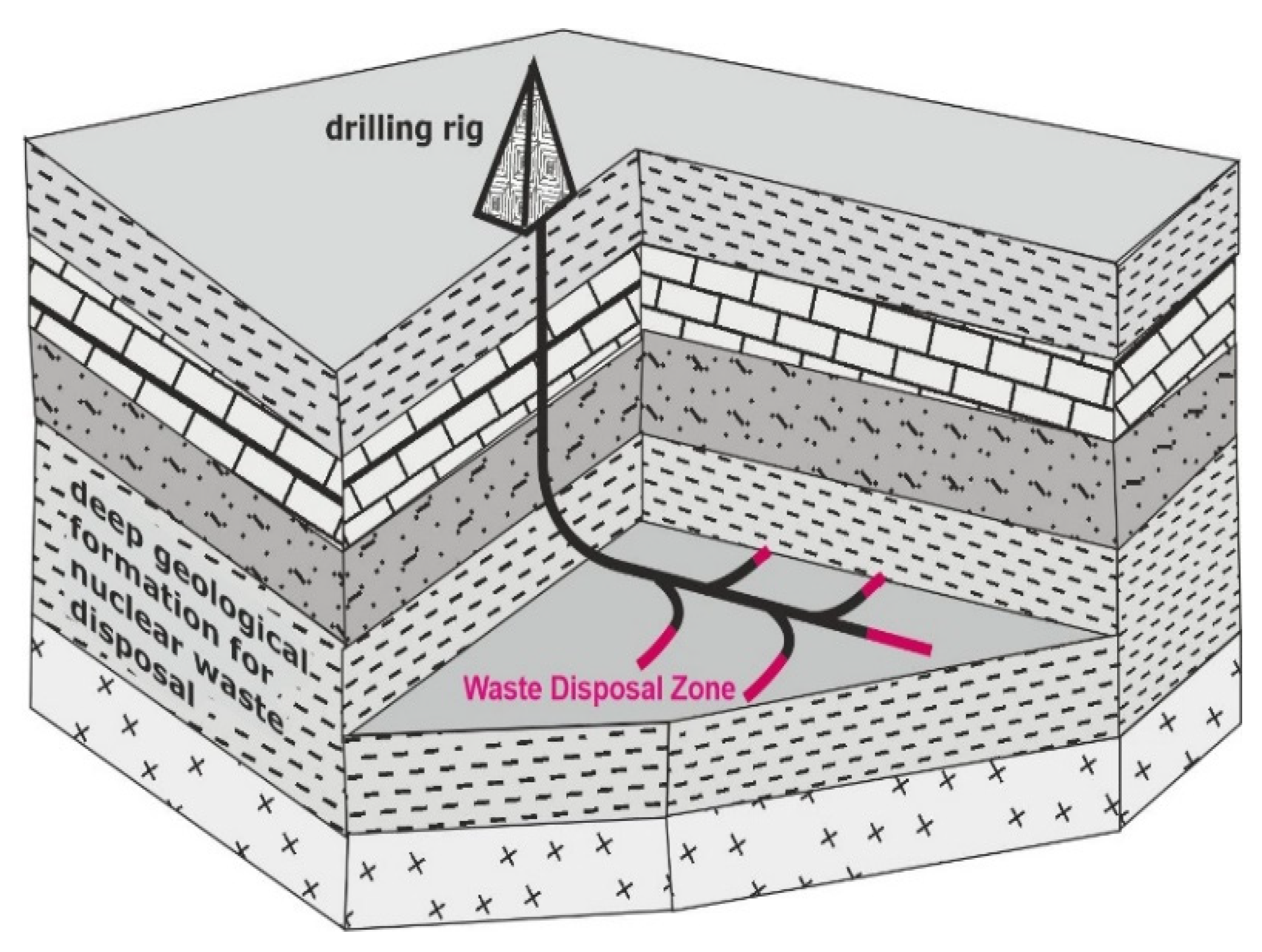
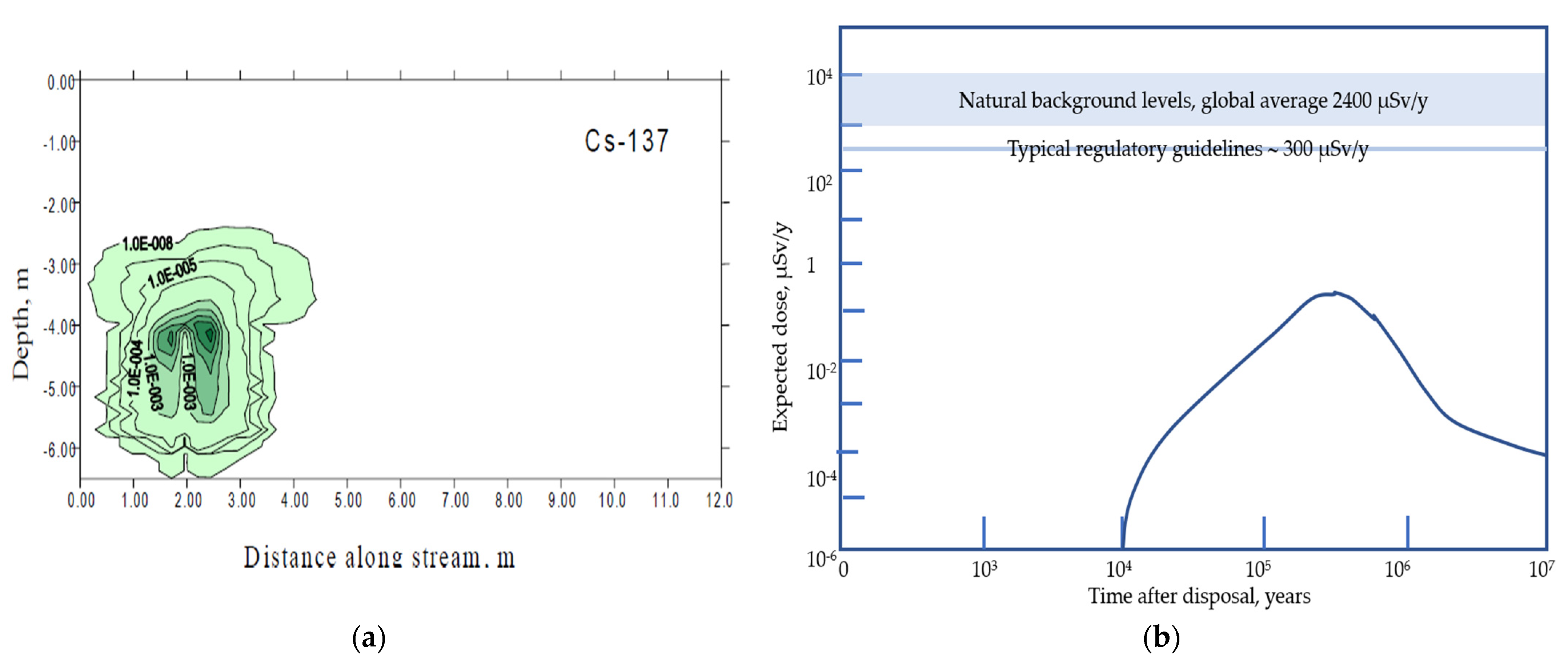
| Waste Class | Parameters |
|---|---|
| VLLW, low volume | Wastes that can be disposed of with ordinary refuse, each 0.1 m3 of material containing less than 400 kBq of beta/gamma activity and is mostly comprised of small volumes from hospitals and universities. For carbon-14 and tritium-containing wastes, the activity limit is 4000 kBq for each 0.1 m3 in total. |
| VLLW, high volume | Radioactive waste with an upper limit of 4 MBq per tonne (not including tritium) that can be disposed of at specified landfill sites. For tritium-containing wastes, the upper limit is 40 MBq per tonne. |
| LLW | Wastes containing radioactive materials other than those suitable for disposal with ordinary refuse, but not exceeding 4 GBq per tonne of alpha or 12 GBq per tonne of beta/gamma activity. |
| ILW | Wastes with radioactivity levels exceeding the upper boundaries for LLW that do not need heating to be taken into account in the design of storage or disposal facilities. |
| HLW | Wastes in which the temperature may rise significantly as a result of their radioactivity, so this factor has to be taken into account in designing storage or disposal facilities. |
| Nuclear Waste Stream | Typical Radioactive Contaminant (Half-Life, y) | Typical Contents, Bq/g | Clearance Level CL, Bq/g | Typical Retention Time 1, y |
|---|---|---|---|---|
| LLW (vitrified) | 137Cs (30.17) | 3.73 × 103 [27] | 0.1 [1] | 457 |
| SNF (burnup 50 GW d/t U) | 237Np (2.1 106) | 1.35 × 106 [28] | 1 [1] | 42.7 106 |
| FEP | Time Frame, y |
|---|---|
| Decay of SNF radionuclides | Millions |
| Climate cycles (glaciations) | Tens of thousands |
| Passive institutional control (markers) | Thousands |
| Decay of ILW radionuclides | Thousands |
| Active institutional control | Hundreds |
| Decay of LLW radionuclides | Hundreds |
| Country | Waste | Wasteform | Container | Backfill |
|---|---|---|---|---|
| Belgium | HLW | Glass | Stainless steel | Clay, Bentonite, Quartz sand, Graphite |
| SNF | SNF | Steel | ||
| Canada | SNF | SNF | Carbon steel, Copper | Bentonite, Sand, Clay, Crashed rock |
| China | HLW | Glass | Stainless steel | Bentonite |
| Czech Republic | ILW | Concrete | Steel | Bentonite |
| HLW | Glass | |||
| SNF | SNF | |||
| Finland | SNF | SNF | Copper, Iron | Bentonite, Crushed host rock |
| France | ILW | Various | Stainless steel, Concrete | Concrete lining |
| HLW | Glass | Stainless steel, Steel | Bentonite | |
| SNF | SNF | Stainless steel | Bentonite, Disposal tube | |
| Germany 1 | LILW | Not considered as EBS | Not considered as EBS | Salt concrete |
| Japan | HLW | Glass | Carbon steel | Bentonite, Sand |
| Korea | SNF | SNF | Steel, Copper, | Bentonite, Sand |
| Russia | HLW | Glass | Steel, Stainless steel | Bentonite, Concrete |
| Spain | SNF | SNF | Carbon steel | Bentonite |
| Sweden | SNF | SNF | Copper, Iron | Bentonite |
| Switzerland | HLW | Glass | Steel | Bentonite |
| UK | LILW | Cement | Steel, Concrete | Cement based |
| US | TRU 2/WIPP 3 | Various | Steel | MgO |
| SNF/YMP 4 | SNF | Stainless steel, Ni-based alloy | - | |
| HLW/YMP | Glass | Stainless steel | - |
| Country | Wasteform | Container |
|---|---|---|
| Belgium | 10,000 y resistance to leaching | Facilitate handling |
| Canada | 10,000 y radionuclide retention | 100,000 y containment |
| Czech Republic | 10,000 y radionuclide retention | 500–1000 y containment |
| Finland | Slow rate of release | 100,000 y containment |
| France | 100,000 y resistance | Facilitate handling |
| Germany 1 | Not part of EBS | Not part of EBS |
| Japan | >10,000 y containment and slow release | 1000 y containment, creating reducing conditions |
| Korea | Resistance to leaching | 1000 y containment |
| Spain | Slow rate of release | 1000 y containment |
| Sweden (KBS-3) | Slow rate of release | 100,000 y isolation |
| Switzerland | 150,000 y low release | Initial period complete containment |
| UK (Nirex, RWM) | 300–500 y limit release | 300–500 y physical integrity, limit release |
| US | WIPP: Not part of EBS; YMP: reduce release rate | WIPP: Not part of EBS; YMP: >10,000 y resistance to corrosion |
| Host Rock | Rock Characteristics | Radionuclide Transport Mechanisms | Country |
|---|---|---|---|
| Granite, gneiss | Fractured, groundwater flow in open fractures. | Advection and diffusion | Canada, China, Finland, Russia, Sweden, UK. |
| Salt bedded, dome | No open fractures, no groundwater. | Diffusion | Germany, USA (WIPP) |
| Volcanic tuffs and lavas | Fractures and pores, unsaturated. | Percolating water | USA (Yucca Mountain). UK (Longlands Farm) |
| Clays and mudrocks consolidated, plastic | No open fractures, stagnant pore water. | Diffusion | Belgium, China, Hungary, France, Russia, Switzerland |
| Disposal Method | Features | Limitations | Waste Subject to Disposal | |
|---|---|---|---|---|
| Landfill sites used for domestic and industrial wastes | Simple and easy to construct and operate No institutional control for disposed wastes Existing facilities can be used | Poor containment and isolation | Exempt waste VLLW | |
| Near-surface facilities | Simple near-surface facilities (trenches) | Excavated trenches covered with a layer of soil Simple and inexpensive Used historically for short-lived LLW Activity concentration limits should be established | Erosion, intrusion, and percolation of rainwater may affect the performance Decay to negligible levels during institutional control period (e.g., 100–300 years) is required Risk of fast migration of radionuclides to biosphere | Waste containing radionuclides with very short half-lives (VSLW), e.g., those often used for research and medical purposes |
| Engineered near-surface facilities | Multi-barrier approach to enhance the safety of disposal Engineered vault repositories Long experience with operationEase of waste emplacement and increased efficiency in the management and closure of the repository | Institutional control (e.g., 100–300 years) is required Erosion, intrusion, and percolation of rainwater may affect the performance | LLW with short-lived radionuclides at higher levels of activity concentration, and also long-lived radionuclides, but only at relatively low levels of activity concentration. | |
| Near-surface borehole or shaft facilities | Alternative or complementary to near-surface vaults.Economical option and also minimises the probability of human intrusion | Size and quantity of waste packages is limitedInstitutional control for up to, e.g., 300 years is required | DSRS 1 | |
| Intermediate-depth facilities | Intermediate-depth shafts or boreholes without EBS | Attractive disposal option for small volumes of waste such as radioactive sources The depth is adequate to eliminate the risk of erosion, intrusion, and percolation of rainwater Flexibility in design Possibility to use existing disused cavities (e.g., mines) | Limited or no contact between percolating water is required Applicable in very low permeability host rocks, with little or no advection of groundwater Good backfilling and sealing are required Extensive characterisation of the site required | Disused sealed radiation sources such as 90Sr, 137Cs, 238Pu, and 241Am |
| Intermediate-depth shafts or boreholes with EBSs | Attractive disposal option for small volumes of waste such as radioactive sources | Significant water inflow or the geotechnical characteristics of the geological materials is allowed Waste containers and packages are important elements in the EBS | Disused high-activity sealed sources | |
| Intermediate-depth repositories | Massive concrete vaults or silos, with additional EBSs such as clay backfills and buffers | High cost Extensive characterisation of the site required | ILW—waste that will not decay sufficiently within the period of institutional control | |
| Deep facilities | Deep boreholes without EBSs | Containment of radionuclides is provided by the geological barrier No requirement for supplementary EBSs Lower flow, more stable chemistry and longer potential return paths to the biosphere | High costLimited volumes of disposed waste | Disused high-activity and long-half-life radioactive sources |
| Deep boreholes with EBSs | Containment of radionuclides is provided by the geological barrier Use of higher flow environments encountered in more permeable geological formations is possible. | High cost Limited volumes of disposed waste | Disused high-activity and long-half-life radioactive sources | |
| Mined geological repositories | May comprise caverns or tunnels with varying types of EBSsContainment of radionuclides is provided by the geological barrier Suitable for all waste categoriesEnhanced confinement | No operational experience for HLW and SFWHigh capital cost Assurance of site integrity for above 10,000 years is required Extensive safety and performance analyses required Suitable geological media required | High-level vitrified waste and encapsulated spent fuelLong-lived LILW Disused sources of any activity and half-life | |
| Waste Class | Cumulative Disposal, m3 |
|---|---|
| VLLW | 273,000 |
| LLW | 65,192,000 |
| ILW | 10,589,000 |
| HLW | 72,000 1 |
| Disposal Method | Country | Facility | Waste |
|---|---|---|---|
| NSDF (trench) | France | CIRES, Morvilliers | VLLW |
| Spain | El Cabril Disposal Facility | VLLW | |
| NSDF (engineered) | France | CSA, department of Aube | Short-lived LILW |
| CSM, near La Hague | Short-lived LILW | ||
| Czech Republic | Dukovany Repository | LLW | |
| Richard Repository near Litoměřice | LLW | ||
| Russia | FSUE RADON near Sergiev Posad | Short-lived LILW, DSRS | |
| Slovakia | National Radioactive Waste Repository Mochovce | LLW | |
| Spain | El Cabril Disposal Facility | VLLW, LLW, ILW, DSRS | |
| UK | LLW Repository at Drigg, Cumbria | LLW | |
| Intermediate depths | Romania | National Repository Baiţa-Bihor | LILW |
| Finland | Loviisa VLJ Repository | LILW | |
| Olkiluoto VLJ Repository | LILW | ||
| Sweden | SFR Forsmark | LILW | |
| GDF | US | WIPP | Transuranic (TRU) waste |
| Yucca Mountain | HLW, SNF | ||
| Sweden | Forsmark site | SNF | |
| Finland | Olkiluoto site | SNF | |
| France | Bure site | HLW, SNF, Long-lived ILW | |
| China | Xinchang site in the Beishan area | HLW, SNF | |
| Russia | Yeniseiskiy site in the Krasnoyarsk Krai | HLW, SNF | |
| Germany | Asse II (former salt and potassium mine, past practice, waste to be retrieved) | Waste with negligible heat generation | |
| ERAM (Morsleben) (former salt and potassium mine, past practice, facility to be closed) | Waste with negligible heat generation | ||
| Konrad (former iron ore mine, under construction including new emplacement vaults) | Waste with negligible heat generation |
Publisher’s Note: MDPI stays neutral with regard to jurisdictional claims in published maps and institutional affiliations. |
© 2022 by the authors. Licensee MDPI, Basel, Switzerland. This article is an open access article distributed under the terms and conditions of the Creative Commons Attribution (CC BY) license (https://creativecommons.org/licenses/by/4.0/).
Share and Cite
Ojovan, M.I.; Steinmetz, H.J. Approaches to Disposal of Nuclear Waste. Energies 2022, 15, 7804. https://doi.org/10.3390/en15207804
Ojovan MI, Steinmetz HJ. Approaches to Disposal of Nuclear Waste. Energies. 2022; 15(20):7804. https://doi.org/10.3390/en15207804
Chicago/Turabian StyleOjovan, Michael I., and Hans J. Steinmetz. 2022. "Approaches to Disposal of Nuclear Waste" Energies 15, no. 20: 7804. https://doi.org/10.3390/en15207804
APA StyleOjovan, M. I., & Steinmetz, H. J. (2022). Approaches to Disposal of Nuclear Waste. Energies, 15(20), 7804. https://doi.org/10.3390/en15207804







